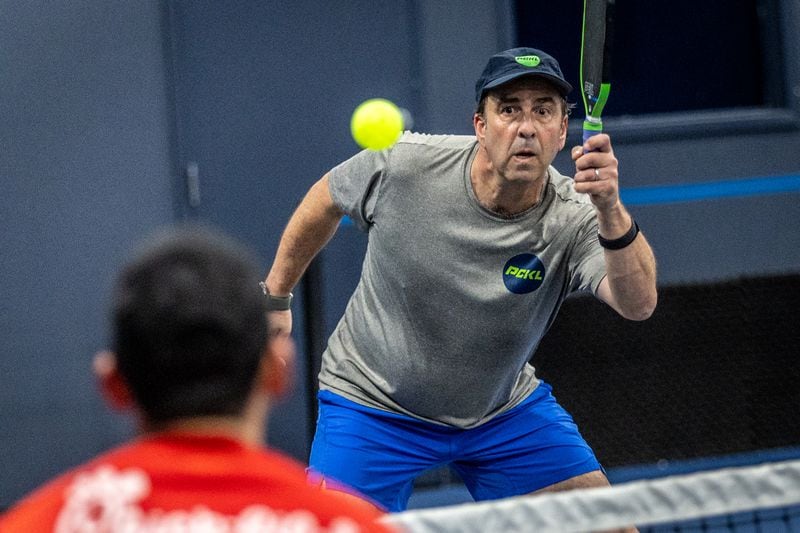As one of the fastest-growing sports in the country, pickleball is seeing an uptick in injuries sustained by some older players who may not properly train to take on a new recreational pursuit, according to Atlanta sports medicine specialists.
At least once a week, The Sports Rehabilitation Center in Brookhaven sees a patient injured from pickleball, said founder and owner Brian Tovin, a physical therapist. Most of the injuries involve a patient’s shoulder or elbow, which Tovin attributes to overuse or from playing with bad form or technique.
Compared to other sports, pickleball is a relatively easy game to learn, played on a smaller court than tennis by players of all ability levels, Tovin said. It requires less running around the court than tennis, and players are physically closer to their teammates and opponents, allowing for conversation during the game. “For many it’s their first introduction to social sports. They don’t know how important it is to warm up.”
His patients are not unique when it comes to pickleball injuries. The American Academy of Orthopaedic Surgeons (AAOS) reported a 90-fold increase in fractures over the past 20 years, mostly among players ages 60 to 69. This trend coincides with the rising popularity of pickleball, which grew nearly 52% from 2022 to 2023 or more than the 200 percent in three years, the Sports & Fitness Industry Association reports.
Women 65 and older sustained the most fractures, falling and injuring their upper body, the AAOS reported. Still, men were more likely to have more serious fractures that required them to be admitted to a treatment facility, often involving the lower body such as a hip or femur, the report revealed.
Marietta resident Steve Horovitz, 69, began playing pickleball three years ago as a way to socialize after he retired as a sales manager from a large import company. He took lessons and played at local parks and residential subdivision courts with a group sometimes as large as 14 players. “I was a reasonable player with a phenomenal serve,” Horovitz contends.
But he admits he “overdid it,” pushing himself too much for his age when he injured his shoulder and leg as a result of playing pickleball up to three hours a day four to five times a week. That was nearly two years ago. As a result of pickleball injuries, among others, his orthopedist and physical therapist advised him not to return to the court.
Horovitz’ experience is why Lee Kneer, an Emory University sports medicine doctor, recommends players begin slowly instead of ramping up too quickly. “Pickleball exploded on the scene and a whole bunch of people are getting into the sport who have not conditioned themselves. It tends to attract those who think they are not fit enough to play tennis. Pickleball is kind of a safer alternative.”
Kneer cautioned about the “inherent dangers of a fast-twitch sport.” He added, “If you play with a competitive spirit, quick, sudden movements put you at risk.”
From personal experience, Kneer saw his competitive nature emerge when he played pickleball, “darting all over the court in ways I would have admonished my patients for doing.”
Instead of treating the opposing player like an adversary, consider them a partner, he said. Start by trying to get the ball across the net “to introduce yourself to the sport and strengthen the muscles and tendons,” Kneer explained. “Start low and go slow in the number of times you play a week and the intensity of playing. Ease into it.” This way, he said, the muscles become “strong enough to withstand the stresses of the sport.”
Injuries can happen even to more experienced and competitive players.
Dan Granot, 58, an Atlanta commercial real estate broker, is ranked among the top 10 senior pro pickleball players in the country. A former competitive tennis player, he took up pickleball in 2018 with some friends and quickly built his skills to win some of the top tournaments in the nation. In 2019, he went to the US Open Pickleball Championships, stepped wrong, ruptured his Achilles tendon, and spent the next nine months recuperating.
Credit: Steve Schaefer /
Credit: Steve Schaefer /
Last year, Granot developed a herniated disc and couldn’t play for five or six months, he recalled. “My lower back is still tight, but I do a lot of stretching.”
He believes people are injured playing pickleball because don’t properly stretch. “The sport has such a low barrier to entry, and you don’t have to have an athletic background to enjoy it. It seems so simple that many people don’t take proper precautions before playing and with all the twisting and turning it makes people vulnerable to injury.”
Tips for new players
Warm up and cool down for at least 10 minutes
Know your body, skill set and limits. If you don’t have a history of exercising, consider starting with only 30 to 60 minutes of pickleball.
Try to increase your flexibility and strengthen your muscles up to 30 minutes, two to three days a week to prevent injuries.
Source: Atlanta physical therapist Brian Tovin
About the Author






